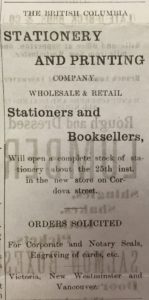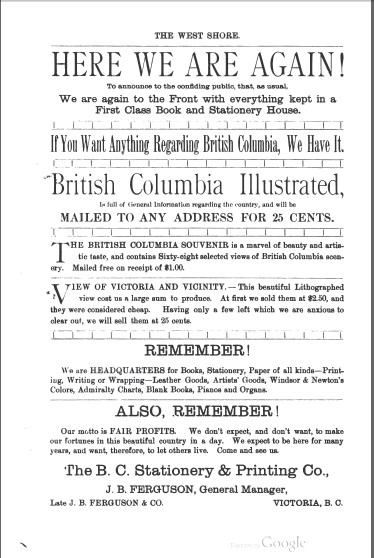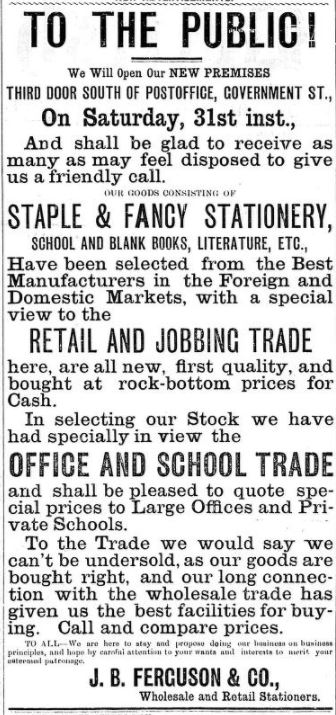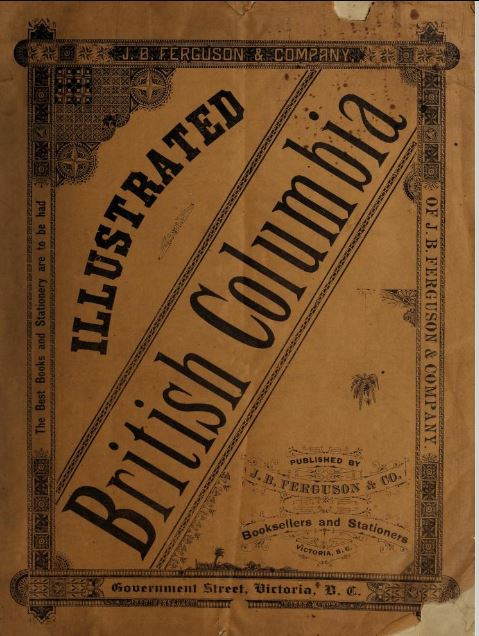Now that I’ve introduced John Bowerman Ferguson, Thomas Robson Pearson, and David Robson, three of the founding partners in the British Columbia Stationery and Printing Company (J.A. Hart was the fourth), let’s continue the story about this firm.
A Promising Start…
Beginning in May 1886 with Pearson’s and Ferguson’s existing book and stationery stores in New Westminster, Vancouver, and Victoria, Robson’s British Columbian newspaper and printing operation in New Westminster, and $50,000 in capital (1), BC Printing and Stationery seemed strongly positioned to compete in the province’s burgeoning bookselling and publishing industry.
…Followed by a Series of Unfortunate Events
But only three weeks after the new firm was incorporated, the Great Vancouver Fire of June 13, 1886, destroyed the company’s Vancouver branch —the same inferno that devastated Seth Tilley’s book and stationery store. BC Stationery and Printing was located on Water Street adjoining the Granville Hotel, and its losses were estimated at $5,750 (2).
Just like Tilley, the firm wasted no time in rebuilding, this time on Cordova Street.

Just as things were settling down in Vancouver, another fire, this one on September 1 in Victoria, destroyed the company’s store on Government Street.
Fortunately, much of the firm’s $25,000 worth of stock was removed as the blaze spread, and insurance partially covered the rest (3). “[The company] will resume business in a few days, and doubtless do a good trade, as they have done heretofore,” declared Books and Notions (4).
And at first it seemed this prediction was right. Through 1887 and into 1888, BC Stationery and Printing’s enthusiastic ads in the Daily Colonist and elsewhere gave no signs that the company was in any distress.

Bankruptcy
But the company was, indeed, in financial difficulty. In January 1887, the partnership between Ferguson, Pearson, and Robson broke apart when Pearson withdrew from the firm, taking his Vancouver and New Westminster branches with him. BC Stationery and Printing also lost the British Columbian and David Robson when the newspaper was sold to a joint stock company controlled in New Westminster (5).
Ferguson tried to press on alone, but in the spring of 1888, BC Stationery and Printing Company declared bankruptcy. Ferguson issued a statement saying that the losses from the Vancouver and Victoria fires in the company’s first year of business, “some serious losses through our jobbing trade,” and “heavy expenses attendant upon the closing up of two branches” had left the firm unable to meet its financial obligations (6).
T.N. Hibben & Co., the company’s staunchest competitor in Victoria, bought the stock of the bankrupt firm at 57½ cents on the dollar, and Ferguson sold what was left of the business to Robert Jamieson (7).
As for John Bowerman Ferguson…
John Ferguson left Victoria in November 1888 and headed back to Winnipeg, where he once again opened a book and stationery store. But again, bad fortune seemed to follow him. First came the death of his wife, Harriett, in November 1891. And then came another bankruptcy, which prompted Books and Notions to conclude that “Mr. Ferguson has a poor record” (8).
But Ferguson didn’t give up. In 1894, he not only remarried, to Helen Walsh, but also reentered the book trade, incorporating Ferguson & Co. once again (9). In 1895, he sold the book and periodical side of this business to Alex Taylor and carried on as a wholesaler of wrapping papers, printing and lithographing papers, and office and school supplies (10).
Then in August 1896, Ferguson left Winnipeg—and the book and stationery business—for good. Over the next dozen or so years, he participated in some mining ventures in the Kootenays, was manager and local treasurer for an American life insurance company in Vancouver, was general manager of the Western Oil and Coal Company, and was involved in the Stave Lake Power Company with Charles Hibbert Tupper (a member of Parliament and son of former prime minister Charles Tupper Sr.), among others (11).
By 1911, Ferguson had returned to his home province of Ontario. He died there in 1919 and is buried in Mount Pleasant Cemetery in Toronto (12).
Notes
(1) “The B.C. Stationery and Printing Company,” Daily Colonist (May 22, 1886): 3.
(2) “Losses,” Vancouver Weekly Herald (June 22, 1886): 2.
(3) “Fire on Government Street,” Daily Colonist (September 1, 1886): 3.
(4) Books and Notions (September 1886): 28.
(5) “The British Columbian Printing Company,” Daily British Columbian (January 28, 1887): 2.
(6) The Commercial, vol. 6, no. 32 (April 30, 1888).
(7) The Commercial (April 30, 1888); Books and Notions (December 1888): 87.
(8) “Ferguson & Co.’s Failure,” Books and Notions (December 1893): 6.
(9) “Wedding Bells,” Manitoba Morning Free Press (May 9, 1894): 6; Books and Notions (June 1894): 14.
(10) American Stationer, vol. 38 (1895).
(11) “Off for Rossland,” Winnipeg Tribune (August 26, 1896): 5; Vancouver Daily World (December 2, 1897): 8; “May Prove an Ore Gusher,” Daily Colonist (December 30, 1905): 6; “Extension Granted,” Vancouver Daily World (January 23, 1902): 2.
(12) Memorable Manitobans: John Bowerman Ferguson; Findagrave.com.
***



